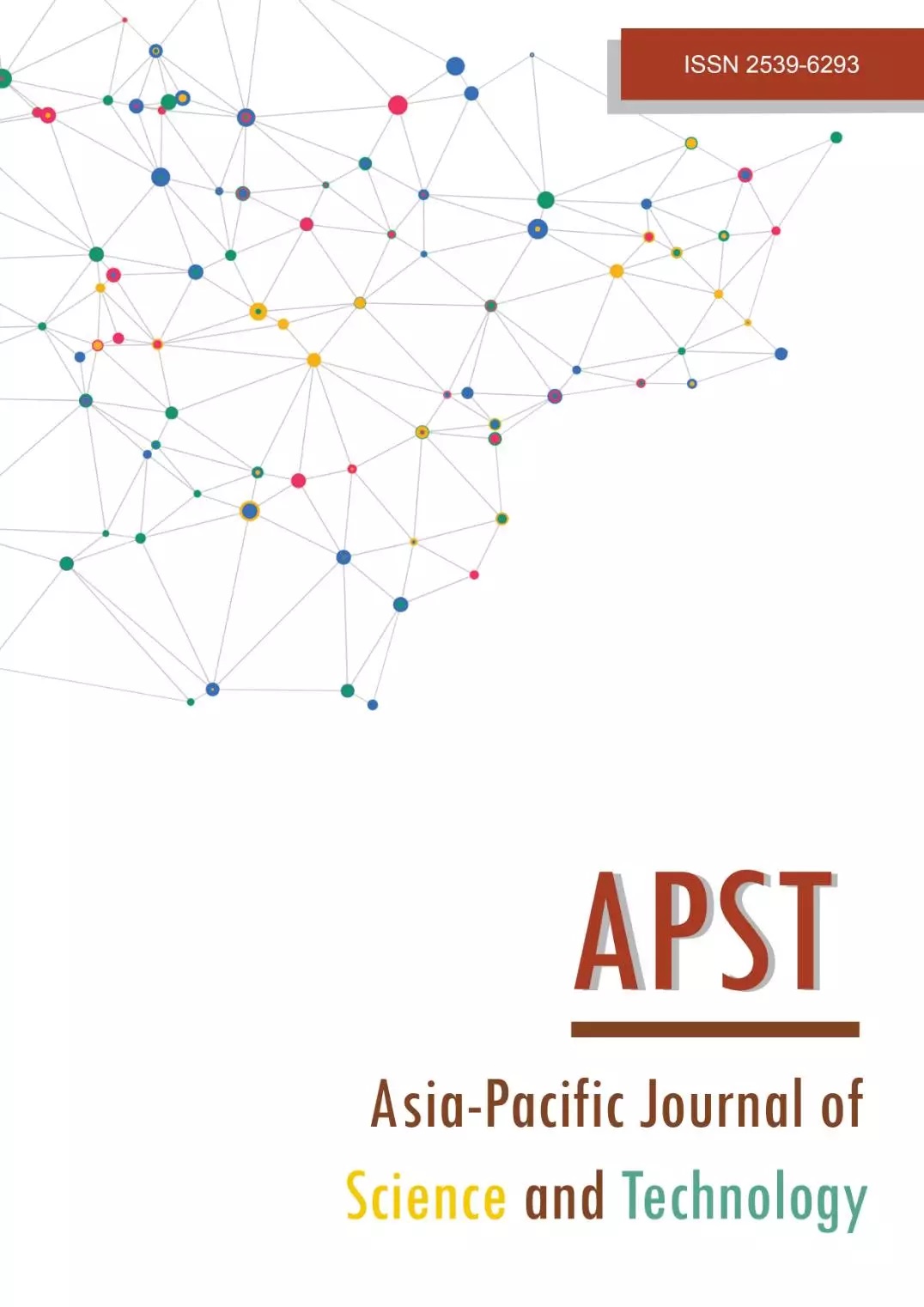Amplified fragment length polymorphism for identification of Habenaria and Pecteilis
Main Article Content
Abstract
Habenaria and Pecteilis are terrestrial orchids that belong to the same subtribe. These two genera exhibit some similar features and are sometimes mistaken for the same genera. Nowadays, the molecular marker method can be used to elucidate the relationship between plants which are different in terms of morphology, but molecular markers can also show similarities between and within genera. There are several molecular markers which can be employed. One of the popular methods is the amplified fragment length polymorphism (AFLP) technique. This technique was used to classify 30 samples of Habenaria and Pecteilis. Among 64 combinations of 8 EcoRI primers and 8 Tru9Ⅰ primers, four primer combinations (E-ATT/M-CAC), (E-AGT/M-CTG), (E-ACA/M-CAC) and (E-ACC/M-CAC) produced clear and polymorphic bands. Similarity coefficients between species indicated that H. erichmichaelii and H. carnea had the closest genetic relationship of 0.60. All samples could be divided into 2 groups. Group 1 consisted of 27 samples of Habenaria with small to large colorful flowers. These samples could be further separated into 3 subgroups, with subgroup 1.1 consisting of Habenaria, which have big and colorful flowers, subgroup 1.2 consisted of Habenaria, which has white, light green or green flowers and subgroup 1.3 consisted of Habenaria, which had small yellow and pink flowers. Group 2 consisted of 3 samples of Pecteilis with large white and yellow flowers. The results indicated that this technique could be used to distinguish Habenaria and alliances.
Article Details

This work is licensed under a Creative Commons Attribution-NonCommercial-NoDerivatives 4.0 International License.
References
Thaithong A. Thailand orchids. 1st ed. Bangkok: Home and garden Printing and Publishing, Co. Ltd.; 2006.
Sittisatchatum S. Orchids 2. 1st ed. Bangkok: Encyclopedia Press. Co. Ltd.; 2007.
Kim SY, Endo M, Yun PY, Kanno A. Production of intraspecific hybrids between wild-type and petaloid-sepal cultivars in Habenaria radiata. Sci Hortic. 2010;124:415-418.
Inthawong S, Bundithya W, Kuanprasert N, Apavatjrut P. Analysis of Intersectional Hybrids of Dendrobium by RAPD Technique. Kasetsart J (Nat. Sci.). 2006;40:456-461.
Duangkhet M, Potapohn N, Bundithya W. Genetic Relationship Analysis of Dwarf Doritis pulcherrima Lindl. by RAPD and ISSR Techniques. J. of Agri. 2014;30:99-109.
Tongkham W, Pumikong S, Potapohn N, Bundithya W. Paphiopedilum charlesworthii var. lannaense, a new slipper orchid from Northern Thailand identified by morphological and AFLP analyses. Phytotaxa. 2022;531 (1):001-017.
Wegadara M, Dewanti M, Diningsih E, Rachmawati F, Sukma D, Sudarsono S. Genetic diversity based on SSR markers of 30 Aeridinae subtribe orchid genetic resources of Indonesian Ornamental Crop Research Institute, Cianjur, Indonesia. Biodiversitas 2022;23 (6):2943-2956.
Deb, C.R., Kamba, J. Molecular characterization and study of phylogeny of some commercially important Vandaceous orchids (Orchidaceae) based on the internal transcribed spacer (ITS). South African J Bot. 2022;146:875-882.
Doyle JJ, Doyle JL. Isolation of plant DNA from fresh tissue. Focus, 1990;12:13-14.
Taywiya P, Bundithya W, Potapohn N. Analysis of genetic relationship of the genus Phalaenopsis by RAPD technique. Acta Hortic. 2008;788:39-45.
Vos P, Hogers R, Bleeker M, Reijans M, Van De Lee T, Hornes M, et al. AFLP, a new technique for DNA fingerprinting. Nucleic Acids Res. 1995 23:4407-4414.
Rohlf FJ. NTSYS-pc: numerical taxonomy and multivariate analysis system. Setauket, New York: Applied Biostatistics In.; 2005.
Kurzweil H. The genus Habenaria (Orchidaceae) in Thailand. TFB. 2009;37:7-105.
Bhattacharyya P, Subhabrata G, Swati SM, Suman K, Tandon P. Genetic variability and association of AFLP markers with some important biochemical traits in Dendrobium thyrsiflorum, a threatened medicinal orchid. S Afr J Bot. 2016;109:214-222.
Chen X, Junjie G, Rui D, Qun Z, Xingze L, Bo Q, Lijun Z. Conservation genetics of the endangered terrestrial orchid Liparis japonica in Northeast China based on AFLP markers. Plant Syst Evol. 2013;299:691-698.
Chang YK, Iqbal MJ, Veilleux RE. Analysis of genetic variability among Phalaenopsis species and hybrids using amplified fragment length polymorphism. J Am Soc Hort Sci. 2009;134:58-66.
Limpiyaprapan S. Orchid. 1st ed. Bangkok: V. Print Company; 2011.
Kawchadee, C., Bundithya W, Sotthikul C, Potapohn N. Interspecific and intergeneric crossability of some Habenaria and Pecteilis, terrestrial orchids. J. of Agri. 2012;28(3): 263-272.
Saikum, C., Kunasakdakul K, Potapohn N. Crossability and in vitro seed germination of some terrestrial orchid species of genus Habenaria and Pecteilis. J Agric. 2020;36(1):47-58.
Sinumporn P, Potapohn N, Bundithya W, Seiichi F, editors. Genetic Relationship Analysis of Habenaria and Pecteilis by RAPD Technique. International Graduate Research Conference 2014; 2014 Dec 12; Chiang Mai,Thailand. Chiang Mai: Chiang Mai University; 2014.
Taywiya P, Bundithya W, Potapohn N. Specific marker for flower color pattern of Phalaenopsis cornu-cervi by AFLP technique. J Agric Res Extend. 2010;27:1-8.
Chen HH, Tsai WC, Lin S, Chen WH. cDNA-AFLP analysis of differential gene expression in the flower buds of Phalaenopsis HSING FEI cv. H. F. and its somaclonal variation. Plant & Animal Genome IX Conference; 2001 Jan 13-17; California, United States. California: Scherago International; 2001. p.323.
Ginibun FC, Bhassu S, Khalid N, Arens P, Vosman B, Othman RY. A preliminary amplified fragment length polymorphism (AFLP) primer selection for Spathoglottis species. Acta Hortic. 2015;1078:167-174.


